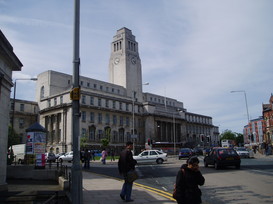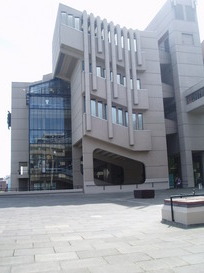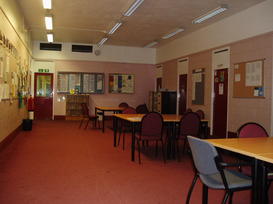A Sense of Place

The official blurb says that The University of Leeds is acclaimed world-wide for the quality of its teaching and research. It always features highly in the lists of the most popular universities in the UK, at least when measured in terms of number of applications. It celebrated its centenary in 2005.
There are over 32000 students at the university, choosing from over 700 first degrees and many postgraduate qualifications. Famous graduates include Jack Straw, Jeremy Paxman and Harold Shipman.
The Parkinson Tower (pictured right) is a prominent landmark in Leeds, and is visible for miles around. It is widely to be the symbol of the university, and was incorporated into a new logo in centenary year. Just underneath the tower is the famous Brotherton library, home to many internationally important collections of documents and books.
The main campus is located just north of the city centre, close enough so that everything in the centre is only a short walk away. Just about everything that a student could need is available on this one site. Most students live in university-owned accomodation in their first year and then move into "LS6", the student ghetto, (made famous in Soft Cell's "Bedsitter") for the remainder of their time.
The city of Leeds itself is regularly touted as one of the fasted growing cities in the north of England. The centre is home to all manner of shopping opportunities, including a branch of Harvety Nichols. At night there are pubs and bars to suit all tastes and a vibrant nightlife. This last is a significant attraction for many students.

Architecturally, the university is quite an eclectic mix with the traditional red brick buildings of the university's earliest days contrasting rather with some of the less pleasing excesses of the 1970s, built as the university extended down the hill towards the city centre. More recent buildings have tended back towards red brick. There are still plenty of green spaces, and even a pond, home to the popular university duck and her family. Unlike many other comparable institutions in the UK, Leeds therefore has quite a creditable duck density score, well inside the top five in the UK.

The University of Leeds was one of the first in the country to offer degrees in computing. Today, the School of Computing is located in one of the 1970s buildings, spread across a number of floors. There are about 100 undergraduate students in each year, and many postgraduates. The School's current research strengths are in artificial intelligence (computer vision in particular), theoretical computer science and transport scheduling.
The centre of the School, at least as far as the students
are concerned is the "Long Room", so called because it is a room and it
is long (those with long memories remember it as a collection of shorter
rooms).
 This place provides desks to work at, handily close to the offices of
teaching staff, who are mostly located nearby and many of whom have open
doors. The labs are not too far
away, there are power and network connections for those disinclined to
walk very far, and many students choose to make this their main work area.
It is, curiously, painted pink.
This place provides desks to work at, handily close to the offices of
teaching staff, who are mostly located nearby and many of whom have open
doors. The labs are not too far
away, there are power and network connections for those disinclined to
walk very far, and many students choose to make this their main work area.
It is, curiously, painted pink.
Footnote: The University Duck
By happy chance, the university duck was in residence while the pictures for this page were being taken. This creature lives on the (allegedly toxic) pond adjacent to the main lecture theatre block. The keen-eyed will spot the duck perching on one of the rocks to the right of the pond.